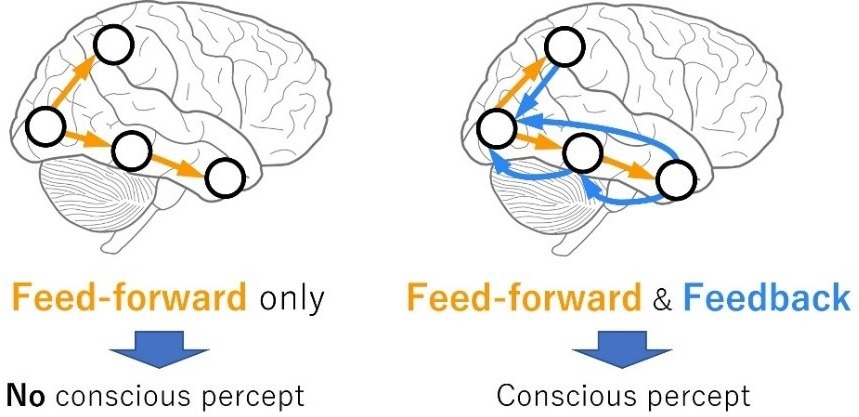Science might be a step nearer to comprehending where consciousness is located in the brain. A new research study demonstrates the significance of particular types of neural connections in locating consciousness.
 Importance of bidirectionality for consciousness. It has been suggested that the part of the brain network supporting consciousness brain regions should be bidirectionally connected because both feed-forward and feedback processes are necessary for conscious experience. For example, previous studies examining visual perception have shown that conscious perception does not arise when there is only feed-forward processing, whereas it arises when there is feedback, as well as feed-forward processing. Image Credit: 2022 Jun Kitazono
Importance of bidirectionality for consciousness. It has been suggested that the part of the brain network supporting consciousness brain regions should be bidirectionally connected because both feed-forward and feedback processes are necessary for conscious experience. For example, previous studies examining visual perception have shown that conscious perception does not arise when there is only feed-forward processing, whereas it arises when there is feedback, as well as feed-forward processing. Image Credit: 2022 Jun Kitazono
The study was published in Cerebral Cortex and was headed by Jun Kitazono, a corresponding author and a project researcher in the Department of General Systems Studies at the University of Tokyo.
Where in the brain consciousness resides has been one of the biggest questions in science. Although we have not reached a conclusive answer, much empirical evidence has been accumulated in the course of searching for the minimal mechanisms sufficient for conscious experience, or the neural correlates of consciousness.”
Masafumi Oizumi, Corresponding Author and Associate Professor, University of Tokyo
Oizumi is also the head of the lab that is performing the study.
For this research, the team forwarded a step toward locating the minimally adequate subnetworks present in the brain that support conscious experience.
To locate the brain areas where consciousness is located, the scientists searched for one particular consciousness hallmark within the brain’s neural networks: bidirectional pathways. When humans look at something or feel a sensation, the brains receive information.
This is known as a feed-forward signal, but getting those feed-forward signals is not sufficient for consciousness. The brains also have to deliver information back, which is known as feedback. Not all parts of the brain could both get feed-forward and send back feedback information. Scientists theorized that such bidirectional connections are an important hallmark of the parts of the brain, which are accountable for consciousness.
Feed-forward processing alone is insufficient for subjects to consciously perceive stimuli; rather, feedback is also necessary, indicating the need for bidirectional processing. The feedback component disappears not only during the loss of specific contents of consciousness in awake states, but also during unconscious states where conscious experiences are generally lost, such as general anesthesia, sleep and vegetative states.”
Jun Kitazono, Corresponding Author and Project Researcher, Department of General Systems Studies, University of Tokyo
He also described that the bidirectionality of processing remains important, regardless of whether it is a human, mouse, monkey, fly, or bird.
Scientists employed a mouse connectome and computational strategies to assess their idea. A detailed map of the connections in the brain is a connectome. Initially, they established a successful algorithm to extract the brain parts with strong bidirectional connections known as complexes. Later, they implemented the algorithm to the mouse connectome.
We found that the extracted complexes with the most bidirectionality were not evenly distributed among all major regions, but rather are concentrated in the cortical regions and thalamic regions. On the other hand, regions in the other major regions have low bidirectionality. In particular, regions in the cerebellum have much lower bidirectionality.”
Jun Kitazono, Corresponding Author and Project Researcher, Department of General Systems Studies, University of Tokyo
These results coincide with where researchers have long-perceived consciousness to be residing in the brain. The cerebral cortex, situated on the brain surface, includes motor areas, sensory areas, and association areas that are believed to be vital to consciousness experience.
The thalamus, which is situated in the middle of the brain, has similarly been believed to be associated with consciousness, and in specific, the communication between the thalamus and cortical regions, known as the thalamo-cortical loop, is regarded essential for consciousness. These findings support the notion that the bidirectionality in the brain network is important to locating the place of consciousness.
Researchers highlighted that they are still continuing their work toward locating the place of consciousness.
“This study focuses only on ‘static’ anatomical connections between neurons or brain areas. However, consciousness is ‘dynamic,’ changing from moment to moment depending on neural activity. Although anatomical connections tell us how neural activity would propagate and how brain areas would interact, we need to directly investigate the dynamics of neural activity to identify the place of consciousness at any given moment,” added Oizumi.
As a step forward, he said the team is now examining activity-based networks of the brain in different kinds of neural recordings.
“The ultimate goal of our lab is to find the mathematical relationship between consciousness and the brain. In this study, we have attempted to relate the network properties of the brain to the place of consciousness. We will further investigate the relationship between consciousness and the brain, toward what is our ultimate goal,” he concluded.
Source:
Journal reference:
Kitazono. J., et al. (2022) Bidirectionally connected cores in a mouse connectome: towards extracting the brain subnetworks essential for consciousness. Cerebral Cortex. doi:10.1093/cercor/bhac143